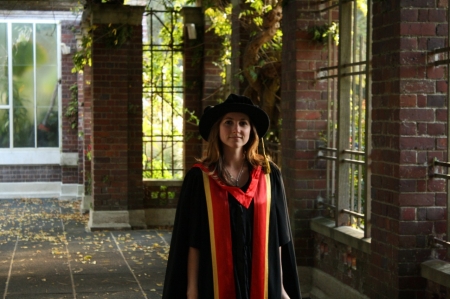Katherine Heays completed her PhD in Civil Engineering in 2012 and now works for Tonkin & Taylor in the Water Resources Group
Katherine discusses her doctoral research topic ‘Cluster Formation and Stream-bed Armouring: A photogrammetric study’ and her experiences at the University of Auckland.
“There is a certain mystery behind water, erosion and sediment that this lab is dedicated to exploring. The fact that this research ties into helping understand the effect of natural forces on man-made structures such as bridges makes the research very relevant, especially in the context of New Zealand where there is so much water everywhere,” Katherine says.
Environmental implications
My research focused on the development of a new method for measuring sediment transport rates in rivers. We used photography to record the motion of sediment on the river bed. Then I developed an algorithm to track the motion of particles. This work is useful in its own right. However it also acts as a stepping stone for other researchers to use and advance the field of sediment transport measurement.
Ultimately this can be applied to help solve some of the mysteries of sediment motion. Erosion is a major risk in some of our nation’s rivers, so understanding sediment transport can protect both man-made structures and natural environments from physical degradation.
The Hydraulic Engineering Lab in Symonds Street
“My research was conducted at the Hydraulics Lab in the engineering building on Symonds St. This lab was packed full of amazing equipment, some of which dated back to the 70s. I loved working with this stuff! It was all really solid, good quality instrumentation that you could rely on. I used really new technology, such as very good quality cameras, to undertake advanced research. There are really good lab technicians there who worked with me and my supervisors to help us achieve exactly the set-up that we needed,” she explains.
Support and Supervision
“There are some excellent minds at the University. There are a good mix of seasoned experts and bright young enthusiastic scholars. I am particularly grateful to Bruce Melville and Heide Friedrich.
“My research was really hands on, and I spent a lot of time in the lab working with the flumes, water and rocks. It was really fun getting my hands dirty and using sophisticated technology to explore my subject. This provided a nice balance with all the thinking that goes with doing a PhD,” she says.
Working for Tonkin & Taylor
Following her PhD Katherine found a challenging and stimulating role in Tonkin & Taylor’s Water Resources Group. She uses the skills that she learned at the University every day.
“I really enjoy my job, but it is much more varied than what I was working on when I did my PhD. My PhD taught me a lot of useful skills such as how to research effectively and problem solving, so I use that aspect of it on a daily basis, but only occasionally do I get to work on problems that directly relate to my research topic.”
Katherine funded her postgraduate study with the help of a University of Auckland Doctoral Scholarship. “This paid my fees and gave me a living stipend. This was critical for me to do my study and I am very grateful to the university for awarding it to me. I hope they keep it up with future students!” she says.
Choosing the University of Auckland
The University of Auckland has a lot of interesting activities going on that I enjoyed. There were often very interesting public lectures and local theatre activities to partake in. The campus has a lot of amenities to offer, such as the gym, medical centre, plenty of cafes, and it is set very close to Albert Park and the City, which makes it easy to get a good work-life balance.
